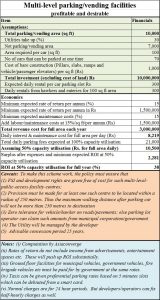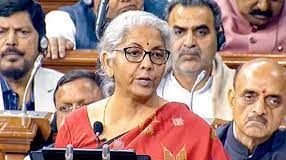Source: http://www.moneycontrol.com/news/trends/current-affairs-trends/a-solution-to-indias-parking-hawker-problem-that-kills-graft-rewards-investors-unclutters-roads-2453549.html
Mumbai’s parking and hawker problem can be solved quite easily if the authorities want to
Instead of letting hawkers occupy existing open spaces, the government should allow for more parking-cum-hawking multiplexes. Developers will be happy. So will motorists and pedestrians.
RN Bhaskar — Dec 04, 2017 02:42 PM IST
The issue of hawking is up in the air. So is that of illegal parking. The issues are both political and fiscal. Politically, it provides a means to block revenue collections by one political party. Fiscally, it could mean additional revenues of anywhere between Rs 6-20 crore every day from the city of Mumbai alone.
 The first issue became volatile when hawkers prevented easy access to station platforms. This got highlighted when the unfortunate deaths at Mumbai’s Elphinstone station took place. A political party has taken up this issue to drive hawkers away from stations. That has hit the daily collections of another party, which has been crying hoarse about the regularisation of hawkers.
The first issue became volatile when hawkers prevented easy access to station platforms. This got highlighted when the unfortunate deaths at Mumbai’s Elphinstone station took place. A political party has taken up this issue to drive hawkers away from stations. That has hit the daily collections of another party, which has been crying hoarse about the regularisation of hawkers.
Graft and illegal parking/vending
The figure may appear preposterous. But illegal hawking (and parking) is a cash cow for any political party that lives on graft.
In January 2013, a hawkers union — which claimed a strength of more than 1.25 lakh hawkers in Mumbai — went public with a claim that the police department and the municipal corporation (MCGM) together extort almost Rs 1,000 crore each year from hawkers to allow them to do business. At that time, of the over 4 lakh hawkers in the city, there were only 26,000 licenced ones.
Currently, estimates suggest that there are 14,000 licensed hawkers in Mumbai and around 150,000 unlicensed ones. The BMC has proposed increasing the number of hawkers in Mumbai from 22,097 to 89,797 by creating hawking zones (often on open spaces which will further reduce the number of such spaces in the city.)
On November 22, 2017, the hawkers went public with statements that a bribe of Rs 1.5 crore is paid to the police and the BMC each day to permit illegal hawking. As mentioned above, this is a far cry from this correspondent’s estimates of Rs 6-20 crore per day.
So does Mumbai have to live with graft? Can’t both parking and illegal hawking get legalized? The answer is yes. The solution is simple. But it won’t be accepted, because it will make at least Rs 6 crore of daily illegal picking disappear. There are strong vested interests in keeping hawkers work illegally. Similarly, there are very powerful interests that do not want to solve the problem of illegal parking.
So what’s the solution?
The way out
First, remember that hawkers come on to a place where there are customers. The customers need hawkers because they are convenient to reach. Thus, there is a symbiotic relationship between hawkers and customers. The trick is to provide both an answer without treading on the rights of motorists, pedestrians and children (who need open spaces).
This correspondent believes that – like in most developed countries – the answer could lie in multi-level parking. But given India’s population, and the fact that many do not have cars that need to be parked, the multi-level parking concept needs to be meshed with vending zones for hawkers and for eateries as well.
Typically, a multi-level parking/vending zone should have the following features:
- Reserve the ground floor for toilets, cab parking, and parking of government vehicles and emergency vehicles (police/fire-brigade etc). They too must pay for parking. Else, you will have the same mess that you see just outside the MCGM headquarters. Around 30-40 government, MCGM and police vehicles crowd pavements and the roadside on any working day. Handicapped persons could also be given the facility of parking on the ground floor (against payment).
- Reserve the first two floors for eateries and food courts.
- Keep the third and fourth floors for hawkers – be they vendors of vegetables, fruit, or trinkets.
- Keep the rest of the floor for car parking. Ideally, the ratio between parking and other facilities should never go below 50:50. Otherwise, developers will make this a shopping zone more than a parking zone.
- If the developer wants, he can create spaces for entertainment; have halls for marriages etc in the same building.
- Thus, the person who wants to come to eat, or make purchases, can do so, hail a cab from the same building and get off near his next destination. If he has a car, he can load his goods into the car within the same premises and then drive away.
- The scheme will work only if there are enough parking multiplexes — at least one within a radius of 250 metres. Thus, the maximum distance a person may have to walk from where he is to the parking lot is just 250 metres. Not a long distance at all.
- Keep the fee at a flat Rs 300 per day – which is the approximate going rate the hawker pay to the police and the municipal authorities in most places according to tales told by hawkers and through media reports. This could be broken up into rentals for 30 minutes to facilitate short-time parking facilities.
- Have a zero tolerance for any hawker, vendor, stall, or vehicle on roads and pavements. Roads were meant for moving vehicles, not for parked ones. And pedestrians have the sole right (not the first right) to pavements.
Is this workable?
Yes. It is profitable. The developer can expect a return on capital (excluding land costs) of a minimum of 38 percent. And this does not include money from advertisements, display windows, catering for parties etc.
As the table alongside shows, the maximum area each car would occupy is around 100 square feet. That would allow the car to manouvre itself into the slot, or exit from the place. Moreover, we have assumed that 30 percent of the floor space is kept free for pathways and utilities (elevators, stairs etc).
You can work the numbers yourselves. Just assume a 50 percent capacity utilization, and you will discover that the profits can be substantial.
But the bigger benefit is a more liveable city, with fewer congested roads. Thus if a woman wants to sit in her car and feed her baby, she can go to a parking lot and feed the baby there. You want to rush to the toilet or have a bite? Just park your car, go to a cafeteria, or to the toilet in the same building.
Electronic gates and access control systems with CCTVs could reduce cost and improve efficiency.
And, more importantly, it brings all the graft money into the taxable domain, leaving the police with more time to focus on law and order, and not just looking for ways to make a quick buck.
Preconditions
This system can work only if a few conditions are observed.
- Both the state government and the municipal corporation will have to ensure that there is no fee for development rights. Additional FSI must be granted because the building is then classified as a public utility. That is who one makes the scheme less expensive and more profitable for developers.
- If the profits are good, and the scheme guaranteed for a reasonably long period of time – we recommend a concession period of 25 years – money will pour in. Investors will begin to opt for this scheme because it offers rates of return of over 30 percent which is higher than house/office rentals which barely offer 7-8 percent per annum on investments.
- Such a scheme can work only if there is zero tolerance for any kind of parking or vending anywhere on the roads or pavements within Mumbai and its suburbs. That is why the law must permit a developer to sue the government and claim damages if he finds a vendor or a car illegally parked on the street or pavement. Unless such damages are permitted, the police and the MCGM will always find excuses for permitting some sort of illegal parking or vending. If exceptions are to be made for the infirm or the disabled, they must be codified, and not left to the discretion of a local officer. Discretionary powers are the building blocks for corruption.
- The government/MCGM must encourage the setting up of at least one such centre within a radius of 250 metres from the other such multi-level parking/vending facility. Thus, the maximum walking distance after parking a car will not be more than 250 metres to destination.
- If there are more than two bidders within a given 250 metre radius, it may be advisable to select one of the bidders through an open tendering process on the revenue share he will give to the municipality. This way each centre can remain profitable because he is guaranteed business within the 500 metre diameter area. This exclusivity should be guaranteed for not more than five years since inception, else the spirit of competitiveness will take a back seat.
Win-win for all (except extortionists)
What is more, developers can maximize their profits by adding floors on which they can have marriage halls, and even offices. But the ratio of offices and vending to parking should not fall to less than 50 percent for parking. This ensures that the building remains a place for parking (and vending), and does become a cinema multiplex or some other recreational centre.
Such an approach will give the government several advantages.
It will be able to bring at least Rs 6 crore (or more) per day of sleaze money into the taxable and legal domain. The multiplicity of such centres will ensure that hawkers will be willing to pay higher rentals in premium areas, and lower rentals in non-premier areas. The sheer numbers of parking multiplexes will also ensure that no developer enjoys a monopoly. And the competition will compel developers to offer better services and opportunities.
Thus, instead of letting hawkers occupy existing open spaces, the government should allow for more parking-cum-hawking multiplexes. Developers will be happy. So will motorists and pedestrians. The incidence of graft will then reduce. It will be in keeping with the government’s much touted claim that it wants to reduce corruption. The combination of eateries, vendors, and car parks will make life simpler and cleaner for everyone.










































COMMENTS